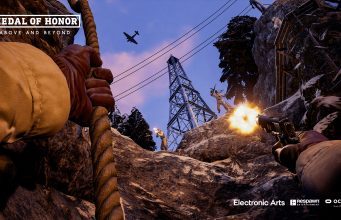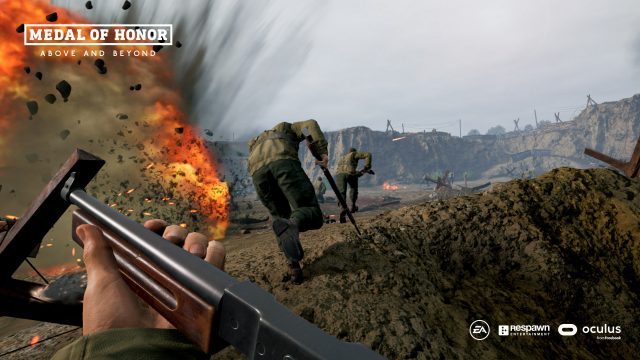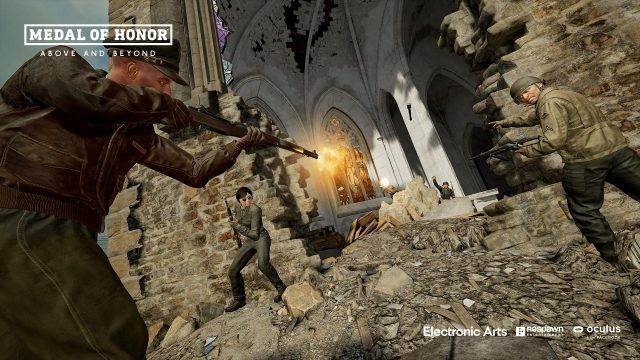
Medal of Honor: Above and Beyond has seemingly everything going for it. The backing of Facebook’s VR publishing arm, Oculus Studios, and development by a world-renowned game studio, Respawn Entertainment. Unfortunately, outside of a competent multiplayer component, the game is missing the kind of core gameplay pillars and polish needed to support the bigger picture of a thrilling war adventure in VR.
Medal of Honor: Above and Beyond Details:
Available On: Oculus PC, SteamVR
Release Date: December 11th, 2020
Price: $60
Publisher: Oculus Studios
Developer: Respawn Entertainment
Reviewed On: Quest 2, Rift S
Gameplay
Medal of Honor: Above and Beyond is a shooting gallery at heart. With imaginative weapons and interesting enemies, that wouldn’t necessarily be a bad thing. But the game’s enemies have effective zero variability from one to the next, neither in the way they approach you or the way you approach them. While there’s a large arsenal of weapons on the surface, the only real choice is whether you’re going to use a close range gun or a long range gun. Outside of that, which weapon you choose has almost no impact on gameplay. Point, shoot, rinse, repeat. After you’ve killed one, you’ve killed them all—which makes killing hundreds of them throughout the game a dull affair.
It doesn’t help that the enemy AI is draft and their lethality feels highly binary. They always know where you, but either miss you completely, or laser you to death through a tiny crack—leaving little room for tension in combat.
Even with these issues in mind, a game could still be fun as long as it has a dynamic sandbox and supplies the player with interesting combat scenarios. Unfortunately Medal of Honor: Above and Beyond also falters here, as the game constantly—and I mean constantly—resorts to simply spawning enemies around corners and throwing them at you, room after room after room.
The game’s persistent shooting gallery is interspersed with a good number of set-piece sequences designed to deliver epic WWII scenarios like commanding a tank, sinking a submarine, or charging the beach at Normandy.
Unfortunately most of the sequences lack the kind of polish that would make them truly fun or challenging, with many moments relying on aiming turrets with a face-cursor and micro-managing the player’s every move. It feels very much like the sequences in the game were picked not because they specifically supported fun VR gameplay, but because they checked the box of what someone imagined would be ‘cool to do’ in a WWII VR shooter. It certainly doesn’t help that the majority of these sequences ignore best practices for VR comfort (more on that in the comfort section below)—but at least you can skip them if you are sensitive to motion.
To make matters worse, the hand-off between regular boots-on-the-ground combat and the novel action sequences has little sense of pace as the player is constantly interrupted with ‘VICTORY’ screen pop-ups and light fanfare music, eradicating any sense of tension the game managed to build. At one point I was discovered as an undercover spy and the enemies knocked me out and captured me. This was apparently a ‘VICTORY’, despite finding myself tied to a chair in the very next sequence.
To top things off, the game’s writing is usually cheesy and at times cringeworthy. Characters you’re ostensibly supposed to care about feel like nothing more than caricatures. At one point a character which is supposedly friendly takes another character hostage by gunpoint; as they attempt to escape, you are instructed to gun them down with a .50 caliber turret. The scene fades to black. ‘VICTORY’ Later in the game the character which betrayed you, held your friend at gunpoint, and which you shot in recompense, returns as a friendly ally of the group with no acknowledgement that any of this happened. A facepalm moment—if not for my forehead being blocked by the headset.
It took me about eight hours to complete the single-player portion of Medal of Honor: Above and Beyond without seeking a handful of collectibles that can be discovered in each mission.
Medal of Honor: Above and Beyond’s single-player campaign might feel banal overall, but at least it has a competent multiplayer component. Though not without some jank of its own, there’s fast-paced action to be enjoyed by those who like to play competitively, even if the cut-throat pace might be more frustrating than fun for some.
Since the game wasn’t live at the time of my review, I only got a few hours of multiplayer play under my belt in scheduled play sessions. Granted, it felt like enough time to feel out the game’s multiplayer vibe overall, which you can read more about in my preview here. The only remaining question is whether or not the game’s multiplayer will attract a healthy player population.
There’s one piece of Medal of Honor that really does go above and beyond, and that’s the game’s ‘Gallery’, a set of live-action documentary shorts featuring WWII vets.
While the serious and reverent tone of the Gallery clashes with the cheesy action-movie feeling of the game’s campaign, it’s an honest-to-goodness documentary-quality production that’s moving to see. Most of the Gallery shorts are presented as high-quality flat video within a virtual theater space, though some of the shots switch to immersive (if low quality) 360 footage for extra impact.
The quality of the Gallery makes it a bit of a shame that it’s stuck inside Medal of Honor: Above and Beyond as a sort of ‘extra’. Oculus should really work to liberate this content from the game so everyone has a chance to see it.
Immersion

While a WWII adventure seems like it would afford many opportunities for immersive gameplay, Medal of Honor: Above and Beyond is missing the attention to detail that makes VR immersion shine, starting with iffy object selection.
There’s very little consistency in non-weapon object interactions. In the same room you might find a teacup which you can grab next to another teacup which is cemented in place with no physics. The very same wrench asset that’s grabbable in one scene might not be grabbable in the next. A desk may be filled with objects where half are interactive and the other half inexplicably aren’t.
This lack of consistency hampers the sense of a ‘solid’ world with consistent rules. While teacups, wrenches, and pieces of paper might be minor details which have no impact on gameplay, it’s the parts that spoil your agency that are the most immersion-breaking. For instance, there was one moment where I was assaulting a German bunker and spotted a ladder to the right of the door. I figured I could sneak in with the ladder instead of taking the direct approach. While there were several ladders like this one elsewhere in the game which could be climbed, when I reached for this one my hand simply phased through it. Moments like these can make the player feel foolish for trying to act on their intuition.
The game’s micromanaging of the player also spoils the sense of agency. You will constantly be told what to do, especially during the set-piece sequences. That’s arguably a good thing—because you’d have little idea what you were doing if the game wasn’t holding your hand—but it winds up feeling like you’re following a set of instructions rather than playing a game. ‘Stand here’. ‘Go there’. ‘Pull the lever’. And yes, even ‘give them a thumbs up to continue’.
Weapon handling is detailed enough to offer some intrigue while staying easy enough to not get in the way of gameplay, but it’s also subject to some interaction inconsistency issues. Weapon reloading requires ejecting a magazine, inserting a new one, and then charging the weapon. But if you forget to charge the weapon you actually can’t grip the gun’s foregrip until you do. In the midst of combat this actually is far more confusing than if I simply attempted to shoot the gun normally and heard a ‘clink’ sound to indicate I had missed one of the steps. Instead (if you forgot to charge the gun) your off-hand will fly confusingly away from the foregrip and to the charging handle. In the head of combat it always took me a moment to put two-and-two together to understand why I couldn’t hold the gun like I was intending to.
Outside of this and some awkward weapon grabbing poses, weapons generally feel pretty good in the game. Although there isn’t enough enemy variety to make your choice of weapon truly matter outside of ‘short range’ or ‘long range’, I did appreciate the few weapons with unique interactions, like the level-action rifle which is cocked with a fun gesture, and the sawed-off shotgun which could be flicked opened and closed for reloading.
One major missed opportunity for building immersion in Medal of Honor: Above and Beyond is audio. The graphics aren’t great, but I at least hoped a AAA studio like Respawn would deliver some industry-leading sound design. Alas, the game’s audio is merely passable.
Last but not least, be warned: if you don’t have the necessary 170GB of SSD space and choose to play on an HDD instead, you’ll be in for some painfully long loading screens.
Comfort

Medal of Honor: Above and Beyond relies entirely on smooth locomotion and expects constant stick movement and strafing. While there’s a range of comfort options—like blinders, smooth turn, snap turn, seated, and standing—no teleportation is offered.
Further, many of the game’s set-piece sequences ignore comfort best practices, frequently subjecting the player to tilting horizons, smooth turning, roller-coaster motions, and occasionally craning your neck in uncomfortable ways.
While it’s arguably good that the game warns players that certain sequences will include intense motion and offers the option to skip, it’s a shame than seemingly 10–20% of the game is made up of these sequences, many of which will be nausea-inducing to those which are sensitive to virtual motion. What’s more, skipping the sequences can sometimes mean missing the conclusion of a mission, resulting in an unceremonious return to HQ with no explanation of what happened.
The game also uses a ‘face-scope’ approach to sniper scopes, which blacks out your peripheral vision and draws a zoomed view onto your face. The view through the scope has tons of latency and also poor image quality, making sniper rifles largely a nuisance to use.
The post ‘Medal of Honor: Above and Beyond’ Review – War Never Felt so Bland appeared first on Road to VR.
Ream more: https://www.roadtovr.com/medal-of-honor-above-and-beyond-review-war-never-felt-so-bland/
No comments:
Post a Comment